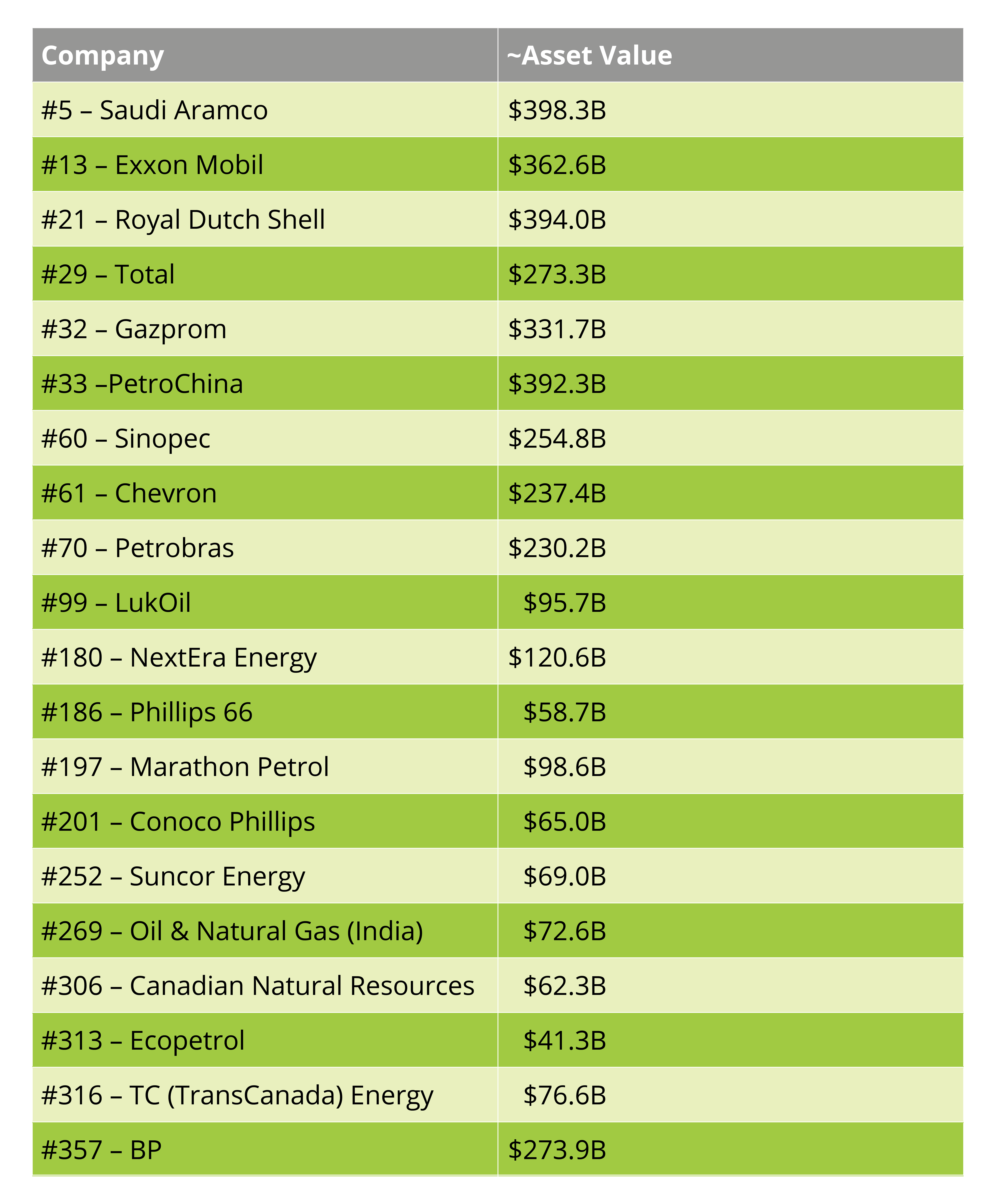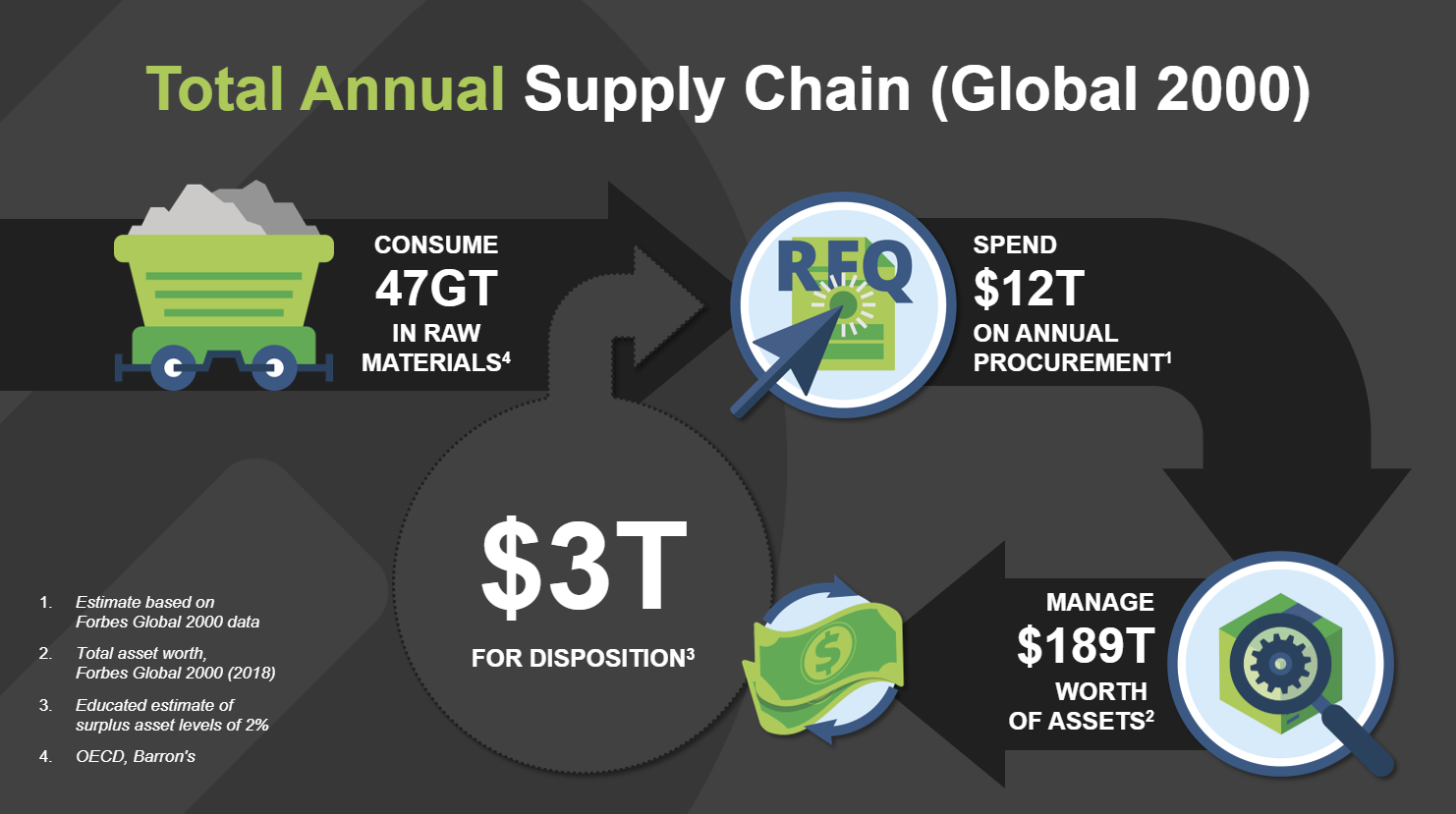August 13, 2020
The Massive Opportunity Waiting for Better Oil and Gas Asset Management
In this article:
- Why oil and gas operators should be selling more of their idle assets
- How they could be getting more for what they sell
- The PR win they’ll gain when they sell the right way
We’ve already talked about the opportunity for the Global 2000 enterprises to generate free cash by selling unused assets. When we share these numbers, people are consistently astounded to learn how big they are:
- $189 trillion: the total value of assets owned by the Global 2000 in 2018, according to Forbes.
- $12 trillion: the annual procurement spend by the Global 2000 (our estimate based on several sources, see image below).
- $3 trillion: the amount of free cash that the Global 2000 could generate by selling just 2% of their idle assets (conservative estimate).
As Brian Aoaeh pointed out, these numbers are so huge that even a small improvement can have a dramatic effect. Their size means that even when you zoom in to individual verticals, the numbers stay almost as impressive.
One of the Requis team’s primary industries is energy, and here we can offer an even more focused picture of the potential gold mine in asset disposition that most operators haven’t tapped into yet.

Current Value of Oil and Gas Assets
While the energy vertical is facing some challenges due to reduced demand in 2020, the downturn for oil and gas won’t last, and the smart players are finding efficiencies.
Some operators are taking advantage of disposition opportunities as projects are paused or cancelled, while others are buying assets they know they will need.
Here’s a look at the potential waiting in energy assets:
- $4 trillion: the value of accumulated assets held by the top 20 energy companies in the Forbes Global 2000 2020 list.
- $1.8 to $1.9 trillion: the overall capex (procurement) spend for global energy in the past three years according to the World Energy Investment 2020 report by the IEA (who predicts a reasonable 20% decline in 2020).
- $25 billion: the average annual asset sale for oil and gas majors from 2012 – 2018 according to the IEA’s World Energy Investment 2019 report. Total asset sales from this period were about $118 billion.
- 1.3%: the approximate value of assets sold as a percentage of assets managed. Note that we can’t tell if the operators got full value for the assets sold; this number is just for discussion.
The charts below provide a condensed look at the data we used to calculate these numbers.

Fig 1: Asset value of energy companies on the Forbes Global 2000 2020 list.

Fig 2: Total annual asset sales for oil and gas majors, IEA
If, just as a thought exercise, we took that 1.3% as a benchmark for the percentage of assets sold by these energy companies, it would be a sign that asset disposition sales are much lower than they should be. These organizations probably aren’t aware of the full extent of the surplus market—more on that below.
We feel that these same organizations should be selling at least 5% of their asset collection every year. If they did, they would have earned about another $80 billion.
The Investment Recovery Association is even more ambitious. Their site states, “At any point in time, up to 10% of a large organization’s total assets are either non-performing or surplus.
The average holding cost for surplus oil and gas assets and stored inventories is 20% of the book/fair market value.”
How We Know There Are More Idle Assets Waiting to Be Sold
Our team has spent a lot of time not only talking to hundreds of supply chain professionals in most of the major oil and gas operators, but also touring the massive warehouses and storage yards where idle assets are kept.
Our contacts corroborate the statement from the IRA site, often complaining that these assets are costing vast sums for storage and maintenance.
If you’re not in energy, you may find this hard to believe. Believe it.
Here’s why. Oil and gas supply chain is generally project-based. Once a drilling site is chosen and the geologists and other technical experts have figured out what it will take to extract the resources, a major procurement initiative begins.
To preserve schedules, procurement typically errs on the side of caution, ordering more than they need. With both onshore and offshore projects, incredibly large collections of equipment must be loaded onto a ship for at least part of their journey to the site.
If the project team notices a shortage, it could be weeks or even months before the additional assets can be ordered, scheduled for loading at the port, and delivered to the final site.
Extra deliveries like this are much more expensive than simply ordering a new gadget online, and meanwhile, work at the site is delayed, which also costs money. It simply makes financial sense to order more, when in doubt.
As a result, however, there is always surplus or used assets that are not only unproductive, they are costing their owners money.
Other verticals, like mining and resources, are in the same situation, as they too initiate projects in remote areas under challenging conditions.
Is Your Organization Getting the Best Value for Asset Disposition?
The potential from disposition goes beyond how much you sell. It’s also about how much you get for each asset.
In energy, it’s far too common to see disposition treated like a garage sale. Disposition activities, when done correctly, can not only reduce total cost of ownership, they can be a welcome source of free cash for the organization.
By “done correctly”, we mean that disposition should begin with selling to other buyers before assets are offered to scrappers. These buyers include other enterprises, lower-tier operators, refurbishers, and in some cases even selling back to the OEM—all of whom will pay more than scrappers do.
In oil and gas, this kind of disposition practice is a natural fit, because drilling and processing infrastructure is always tailored to the environmental conditions specific to the locale where the operator is working.
Many materials used in equipment deployed in the Gulf of Mexico, for example, don’t work effectively in the North Sea. Salinity, temperature, pH, and geological conditions can vary, not to mention local regulations and standards.
Platforms like Requis make it easy to find other operators who want to buy and sell equipment designed for specific environments.
Further, Requis provides a competitive environment where multiple bids come in for an asset, which means sellers can earn more. In the past, we’ve had bids of $2 million for some assets.
That’s definitely not garage sale territory.
Public Relations and Environmental Benefits
Here’s the benefit that most asset managers won’t expect: while they are generating value for their businesses, they are also creating public relations fuel for free. This is because all disposition managers are closet environmentalists, whether they know it or not.
When assets are sold to secondary and tertiary users, it extends the asset lifespan and helps foster the circular economy.
Getting more use out of each asset means that fewer assets need to be created in the long term, fewer resources need to be extracted, and the environment wins on a number of fronts: greenhouse gas emissions are reduced, less water is diverted, and there is less habitat and biodiversity loss.
Taking an active role in the circular economy not only benefits everyone, it creates numerous opportunities for your organization to promote itself as a good corporate citizen, without having to spend anything extra—in fact, while saving money. It’s the kind of win-win that supply chain strategist and circular economy advocate Deborah Dull has been trying to promote for years.
As if that’s not enough, leveraging the circular economy can also help reduce procurement spend as well, making disposition a value generator on yet another dimension.

Fig 3: leveraging the circular economy reduces demand for raw materials and procurement spend.
Get Requis Oil and Gas Asset Management Software
In order to take advantage of the financial potential in asset disposition, you have to understand what assets you have, where they are, and what they’re doing. You can’t do that with a spreadsheet or even with most legacy ERP systems.
The Requis platform helps your team take asset management and disposition to a higher level, elevating the profile of supply chain within your organization.
